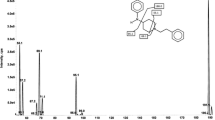Abstract
A liquid chromatography-tandem mass spectrometry (LC-MS-MS) method was developed for the quantitation of carisoprodol and its metabolites, meprobamate and hydroxycarisoprodol, in equine urine and serum. The method consists of solid phase extraction followed by LC-MS-MS using electrospray ionization (ESI) and multiple reaction monitoring. Validation of the method showed excellent sensitivity, selectivity, accuracy, precision and ruggedness. The urinary excretion and serum profiles of these analytes were determined after oral administration of carisoprodol and meprobamate. The determination of hydroxycarisoprodol in urine and/or intact carisprodol in serum allows one to effectively distinguish between specimens arising from administration of carisoprodol (a class 4 drug violation) and meprobamate (a class 2 violation).
Similar content being viewed by others
References
Reeves RR, Carter OS, Pinkofsky HB, Struve FA, Bennett DM (1999) J Addict Diseas 18:51–56
Bailey DN, Briggs JR (2002) Am J Clin Pathol 117:396–400
Gillard Y, Bilault F, Pepin G (1997) Forensic Sci Internat 86:173–180
Kintz P, Mangin P (1993) J Anal Toxicol 17:408–410
The Association of Racing Commisioners International, Inc. (2002) Uniform classification guidelines for foreign substances and recommended penalties and model rule
The Association of Official Racing Chemists (2002) Minimum performance criteria for chromatography and mass spectrometry, AORC Internal Communication
Draft Guidance for Industry, Mass Spectrometry for Confirmation of the Identity of Animal Drug Residues (June 6, 2002) United States FDA Center for Veterinary Medicine
Bressolle F, Bromet-Petit M, Audran M (1996) J Chrom B Biomed Applic 686:3–10
Olsen H, Koppang E, Alvan G, Morland J (1994) Ther Drug Monit 16:337–40
Bossoni G, Colasanti P, Bianchi S, Riva M, Usardi MM (1979) Pharmacol Res Commun 11:693–702
Author information
Authors and Affiliations
Corresponding author
Additional information
In Honour of Professor Edward Houghton: A Celebration of 30 Years in Racing Chemistry
Rights and permissions
About this article
Cite this article
Skinner, W., McKemie, D. & Stanley, S. Quantitative Determination of Carisoprodol and its Metabolites in Equine Urine and Serum by Liquid Chromatography-Tandem Mass Spectrometry. Chromatographia 59 (Suppl 1), S61–S67 (2004). https://doi.org/10.1365/s10337-004-0244-6
Received:
Revised:
Accepted:
Published:
Issue Date:
DOI: https://doi.org/10.1365/s10337-004-0244-6




